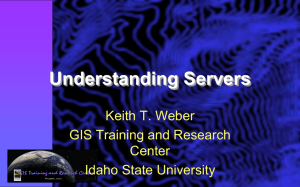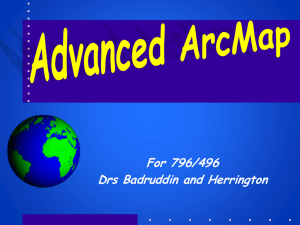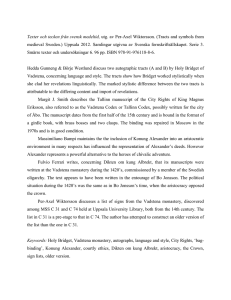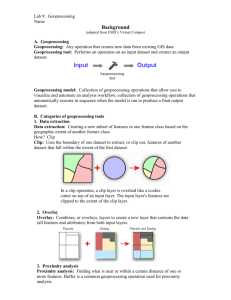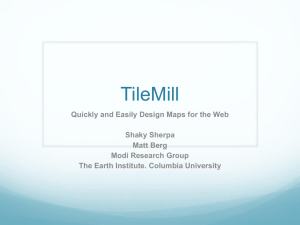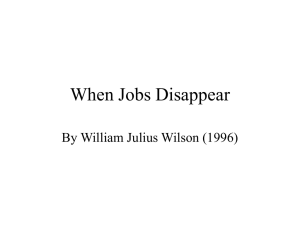lecture 7 ppt
advertisement
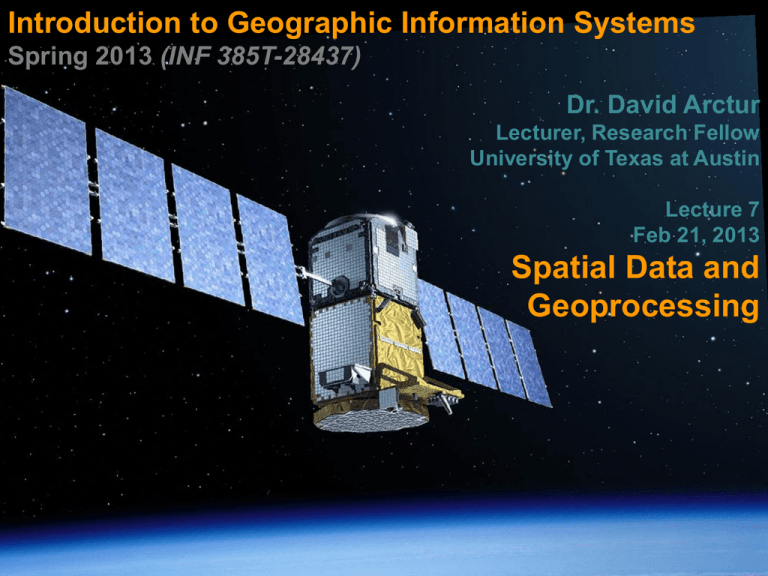
Introduction to Geographic Information Systems Spring 2013 (INF 385T-28437) Dr. David Arctur Lecturer, Research Fellow University of Texas at Austin Lecture 7 Feb 21, 2013 Spatial Data and Geoprocessing Outline Bolstad, Ch 5, 6, 7: Data Sources, cont’d GPS, Aerial/Satellite Imagery, Digital Data Gorr & Kurland, Ch 8: Geoprocessing Attribute extraction Feature location extraction Location proximities Geoprocessing tools Model builder INF385T(28437) – Spring 2013 – Lecture 7 2 Lecture 7 MORE ON DATA SOURCES: GPS, IMAGERY, DIGITAL INF385T(28437) – Spring 2013 – Lecture 7 3 Measuring location & data Three main approaches, many technologies: In situ: make field observations on site Stream flow & other gauges, GPS location Remote sensing: observe from a distance Aerial photos, satellite sensors, LiDAR Model results: products derived from working on other products INF385T(28437) – Spring 2013 – Lecture 7 4 Global Navigation Systems Aka, Global Positioning Systems (GPS) Global Navigation Satellite Systems (GNSS) Uses WGS84 for coordinate reference system Bolstad, p.184 INF385T(28437) – Spring 2013 – Lecture 7 5 GPS Ranging: get 4+ Bolstad, p.189 INF385T(28437) – Spring 2013 – Lecture 7 6 GPS Errors due to receiver sensitivity PDOP: Positional Dilution of Precision (see Bolstad, p.192) INF385T(28437) – Spring 2013 – Lecture 7 7 GPS: Differential Correction Depends on having GPS receivers with precisely known location Differential correction can be applied in real-time or calculated later Bolstad, p.195 INF385T(28437) – Spring 2013 – Lecture 7 8 Remote Sensing Aerial photography Satellite multispectral / hyperspectral LiDAR – Light Detection and Ranging Sensor webs Bolstad, chapter 6 INF385T(28437) – Spring 2013 – Lecture 7 9 Industrial Process Monitor Sensor Webs Sensors connected to and discoverable on Web Sensors have position & generate observations Sensor descriptions available Automobile Services to task and access sensors as Sensor Probe Local, regional, national scalability Enabling the Enterprise Airborne Imaging Device Traffic, Bridge Temp Sensor Monitoring Stored Sensor Data Webcam Strain Gauge Satellite-borne Device Source: OGC – Spring 2013Imaging INF385T(28437) – Lecture 7 Environmental Monitor Health Monitor 10 LiDAR – Laser-based imagery Hi-resolution topography Can separate forest cover from ground layer Bolstad, p.260 INF385T(28437) – Spring 2013 – Lecture 7 11 LiDAR point clouds Bolstad, p.261 INF385T(28437) – Spring 2013 – Lecture 7 12 LiDAR Applications Agriculture yields Biology, conservation Archaeology beneath forest canopy Geology, soil science 3D cave maps, hi-resolution beach topography Meteorology, law enforcement, robotics Adaptive cruise control (autos) Source: Wikipedia INF385T(28437) – Spring 2013 – Lecture 7 13 Spatial Processing Attribute extraction Feature location extraction Location proximities Geoprocessing tools Model builder INF385T(28437) – Spring 2013 – Lecture 7 14 Lecture 7 SPATIAL PROCESSING: ATTRIBUTE EXTRACTION INF385T(28437) – Spring 2013 – Lecture 7 15 Attribute query extraction You have tracts for an entire state, but want tracts for one county only INF385T(28437) – Spring 2013 – Lecture 7 16 Attribute query extraction Select tracts by County FIPS ID Cook County = 031 INF385T(28437) – Spring 2013 – Lecture 7 17 Attribute query extraction Cook County tracts selected Export to new feature class or shapefile INF385T(28437) – Spring 2013 – Lecture 7 18 Export selected features Right-click to export selected features INF385T(28437) – Spring 2013 – Lecture 7 19 Add new layer Cook County tracts INF385T(28437) – Spring 2013 – Lecture 7 20 Lecture 7 FEATURE LOCATION EXTRACTION INF385T(28437) – Spring 2013 – Lecture 7 21 Select by location Powerful function unique to GIS Identify spatial relationships between layers Finds features that are within another layer INF385T(28437) – Spring 2013 – Lecture 7 22 Select by location Have Cook County census tracts but want City of Chicago only Can’t use Select By Attributes No attribute for Chicago Use “Municipality” layer City Chicago is a municipality within Cook County INF385T(28437) – Spring 2013 – Lecture 7 23 Select by location Select “Chicago” from municipalities layer INF385T(28437) – Spring 2013 – Lecture 7 24 Select by location Selection, Select By location INF385T(28437) – Spring 2013 – Lecture 7 25 Export selected features INF385T(28437) – Spring 2013 – Lecture 7 26 Lecture 7 LOCATION PROXIMITIES INF385T(28437) – Spring 2013 – Lecture 7 27 Points near polygons Health officials want to know polluting companies near water features INF385T(28437) – Spring 2013 – Lecture 7 28 Points near points School officials want to know what schools are near polluting companies INF385T(28437) – Spring 2013 – Lecture 7 29 Polygons intersecting lines Transportation planner wants to know what neighborhoods are affected by construction project on major highway INF385T(28437) – Spring 2013 – Lecture 7 30 Lines intersecting polygons Public works official wants to know what streets or sidewalks will be affected by potential floods INF385T(28437) – Spring 2013 – Lecture 7 31 Polygons completely within polygons City planners want to know what buildings are completely within a zoning area. INF385T(28437) – Spring 2013 – Lecture 7 32 Lecture 7 GEOPROCESSING TOOLS INF385T(28437) – Spring 2013 – Lecture 7 33 Geoprocessing overview GIS operations to manipulate data Typically take input data sets, manipulate, and produce output data sets Often use multiple data sets INF385T(28437) – Spring 2013 – Lecture 7 34 Geoprocessing enables decisions Assess Wildfire Danger Geoprocessing Workflow To create derived & value-added products Decision Support Client Internet Base map from NASA Data Pool Coordinate transformation Classify fire areas from aerials Overlay and buffer Roads layer … Data Source: OGC – Spring 2013 – Lecture INF385T(28437) 7 Servers (web services) 35 Common geoprocessing tools Analysis Extract – Clip Overlay – intersect and union Data management Generalization - dissolve General Append Merge INF385T(28437) – Spring 2013 – Lecture 7 36 Finding the tools Geoprocessing menu (slight differences between 10.0 and 10.1) INF385T(28437) – Spring 2013 – Lecture 7 37 Finding the tools ArcToolbox INF385T(28437) – Spring 2013 – Lecture 7 38 Finding the tools Search window INF385T(28437) – Spring 2013 – Lecture 7 39 Clip Acts like a “cookie cutter” to create a subset of features Input features (streets) INF385T(28437) – Spring 2013 – Lecture 7 Clip features (Central Business District) Output features (CBD streets) 40 Clip INF385T(28437) – Spring 2013 – Lecture 7 41 Clip vs. select-by-location Clip Clean edges Looks good Select by location Dangling edges Better for geocoding INF385T(28437) – Spring 2013 – Lecture 7 42 Dissolve Combines adjacent polygons to create new, larger polygons Uses common field value to remove interior lines within each polygon, forming the new polygons Aggregate (sums) data while dissolving INF385T(28437) – Spring 2013 – Lecture 7 43 Dissolve Create regions using U.S. states Use SUB_REGION field to dissolve Sum population INF385T(28437) – Spring 2013 – Lecture 7 44 Dissolve Statistics Fields (optional) (may not be initially visible, scroll down to see) INF385T(28437) – Spring 2013 – Lecture 7 45 Dissolve results States dissolved to form regions Population summed for each region INF385T(28437) – Spring 2013 – Lecture 7 46 Append Appends one or more data sets into an existing data set Features must be of the same type Input datasets may overlap one another and/or the target dataset TEST option: field definitions of the feature classes must be the same and in the same order for all appended features NO TEST option: Input features schemas do not have to match the target feature classes' schema INF385T(28437) – Spring 2013 – Lecture 7 47 Append DuPage and Cook County are combining public works and need a new single street centerline file. INF385T(28437) – Spring 2013 – Lecture 7 48 Append Append will add DuPage streets to Cook County streets INF385T(28437) – Spring 2013 – Lecture 7 49 Resultant layer One street layer (Cook County) with all records and field items INF385T(28437) – Spring 2013 – Lecture 7 50 Merge Combines multiple input datasets of the same data type into a single, new output dataset Illinois campaign manager needs a single voting district map but wants to preserve the original layers INF385T(28437) – Spring 2013 – Lecture 7 51 Merge INF385T(28437) – Spring 2013 – Lecture 7 52 Resultant layer New voting district layer INF385T(28437) – Spring 2013 – Lecture 7 53 Union Overlays two polygon layers Resulting output layer has combined attribute data of the two inputs Contains all the polygons from the inputs, whether or not they overlap INF385T(28437) – Spring 2013 – Lecture 7 54 Union Neighborhoods and ZIP Codes INF385T(28437) – Spring 2013 – Lecture 7 55 Union INF385T(28437) – Spring 2013 – Lecture 7 56 Union Better describes characteristics of a neighborhood. Central business district 15222 vs 15219 INF385T(28437) – Spring 2013 – Lecture 7 57 Union Attributes tables contain different fields and data INF385T(28437) – Spring 2013 – Lecture 7 58 Union results New polygons with combined data INF385T(28437) – Spring 2013 – Lecture 7 59 Union vs. Merge vs. Dissolve Operation # Input Feature Classes Change in Geometry Schema Restrictions Union Multiple Combines all input geometries Includes all fields from all input feature classes; input tables do not have to be identical Merge Multiple Combines all input geometries Input tables must be identical; retains one set of attributes Dissolve Single Combines feature geometries based on shared attribute values N/A – single feature class schema INF385T(28437) – Spring 2013 – Lecture 7 60 Intersect Computes a geometric intersection of the Input Features Features (or portions of features which overlap in all layers and/or feature classes) will be written to the Output Feature Class Inputs can have different geometry types INF385T(28437) – Spring 2013 – Lecture 7 61 Intersect City manager needs to know what buildings intersect flood zones and wants the flood data attached to each intersecting building INF385T(28437) – Spring 2013 – Lecture 7 62 Intersect INF385T(28437) – Spring 2013 – Lecture 7 63 Intersect result Only building polygons that intersect flood zones with combined data fields INF385T(28437) – Spring 2013 – Lecture 7 64 Lecture 8 MODEL BUILDER INF385T(28437) – Spring 2013 – Lecture 7 65 Model builder overview Workflow processes can be complicated Models automate and string functions together Simplifies sensitivity / parametric studies Example You have census tracts for a county and want to create neighborhoods for a city Many steps are needed to create neighborhoods (join, dissolve, etc) INF385T(28437) – Spring 2013 – Lecture 7 66 Starting map TIGER census tracts and municipalities INF385T(28437) – Spring 2013 – Lecture 7 67 Final map Tracts dissolved to create neighborhoods INF385T(28437) – Spring 2013 – Lecture 7 68 Crosswalk table Neighborhood names are not included with the census tracts, so a crosswalk table was created with the name of neighborhood for each census tract Some neighborhoods are made of multiple tracts INF385T(28437) – Spring 2013 – Lecture 7 69 Geoprocessing options INF385T(28437) – Spring 2013 – Lecture 7 70 Create a new toolbox Catalog INF385T(28437) – Spring 2013 – Lecture 7 71 Create a new model Right-click new Toolbox INF385T(28437) – Spring 2013 – Lecture 7 72 Add tool to model Add Join Tool To join crosswalk table to tracts… INF385T(28437) – Spring 2013 – Lecture 7 73 Set parameter for Join Tool Joins crosswalk table to census tracts INF385T(28437) – Spring 2013 – Lecture 7 74 Model steps Add Join Dissolve Remove join INF385T(28437) – Spring 2013 – Lecture 7 75 Finished model INF385T(28437) – Spring 2013 – Lecture 7 76 Summary Bolstad, Ch 5, 6, 7: Data Sources, cont’d GPS, Aerial/Satellite Imagery, Digital Data Gorr & Kurland, Ch 8: Geoprocessing Attribute extraction Feature location extraction Location proximities Geoprocessing tools Model builder INF385T(28437) – Spring 2013 – Lecture 7 77
